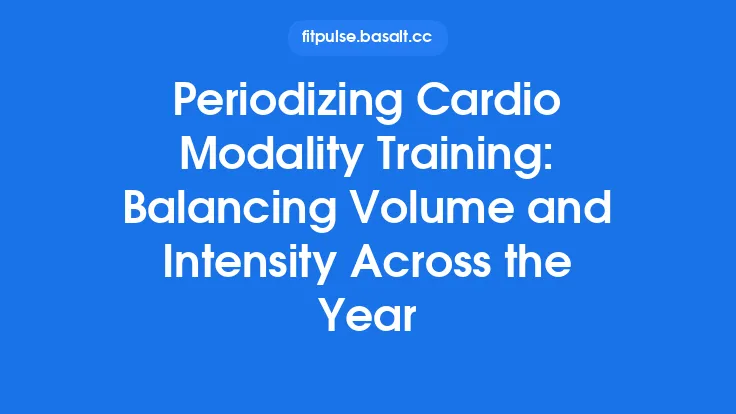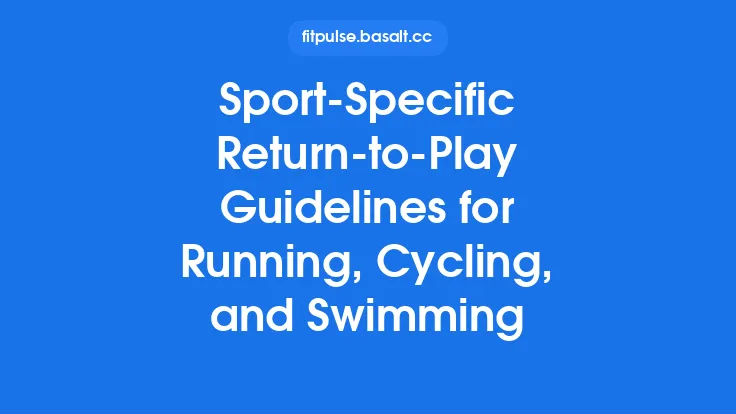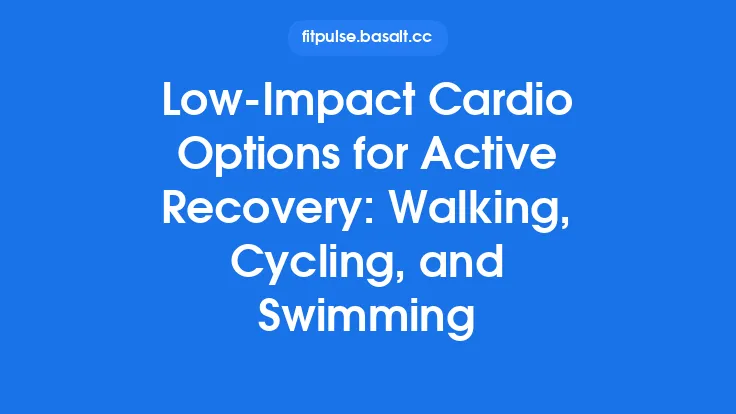Cross‑training with multiple cardio modalities offers a powerful way to develop a well‑rounded cardiovascular system while reducing the monotony and injury risk that can accompany single‑sport training. By weaving running, cycling, swimming, and rowing into a cohesive program, athletes can exploit the unique physiological demands of each discipline, balance muscular stress, and keep motivation high. This article explores the science behind multi‑modal cardio, outlines practical strategies for integration, and provides actionable guidance for building a sustainable, performance‑enhancing routine.
Why Combine Multiple Cardio Modalities?
Complementary Stress on the Body
Each cardio discipline imposes a distinct pattern of muscular activation, joint loading, and energy‑system demand:
| Modality | Primary Muscular Emphasis | Joint Impact | Typical Energy‑System Emphasis |
|---|---|---|---|
| Running | Lower‑body (glutes, hamstrings, calves) | High (repetitive impact) | Aerobic, with bursts of anaerobic during sprints |
| Cycling | Lower‑body (quadriceps, glutes) with minimal impact | Low | Aerobic, with capacity for high‑intensity intervals |
| Swimming | Upper‑body (latissimus, shoulders) + core; full‑body coordination | None (water buoyancy) | Aerobic, with anaerobic bursts in sprint swims |
| Rowing | Full‑body (legs, back, arms) in a coordinated drive | Low‑moderate (seat friction) | Aerobic, with strong anaerobic component during high‑power strokes |
By rotating through these activities, you distribute load across different muscle groups and joint structures, which can mitigate overuse injuries and promote balanced development.
Enhanced Cardiovascular Adaptations
The heart and lungs respond to a variety of stimulus patterns. For example, the high‑impact, weight‑bearing nature of running stimulates bone density and improves peripheral circulation, while the low‑impact, high‑volume nature of cycling and swimming encourages capillary growth and mitochondrial density without excessive joint stress. Rowing adds a powerful stimulus for stroke volume and cardiac output due to its simultaneous involvement of both upper and lower body.
Mental Freshness and Motivation
Switching modalities prevents the mental fatigue that often accompanies repetitive training. The novelty of a new environment—track, road, pool, or rowing machine—keeps the brain engaged, which can improve adherence and overall enjoyment.
Core Principles for Designing a Multi‑Modal Cardio Program
- Define Primary Goals
- Performance‑oriented (e.g., improve race times, increase power output)
- Health‑oriented (e.g., improve VO₂max, manage weight)
- Rehabilitation/maintenance (e.g., reduce impact while staying active)
- Assess Baseline Capacity
Conduct simple field tests for each modality (e.g., 5‑km run, 20‑min bike FTP test, 400‑m swim, 2‑km row) to gauge current fitness levels and identify strengths/weaknesses.
- Establish a Weekly Structure
- Frequency: 3–6 cardio sessions per week, depending on time and recovery capacity.
- Distribution: Aim for at least two different modalities per week, with one “focus” day for the primary goal sport and complementary days for the others.
- Balance Intensity and Volume
Use the Polarized Training Model as a guiding framework: ~80 % of sessions at low‑to‑moderate intensity (Zone 2 heart‑rate or RPE 3–4) and ~20 % at high intensity (Zone 4–5 or RPE 8–9). This model works well across modalities and reduces cumulative fatigue.
- Plan Transitions Carefully
Schedule higher‑impact sessions (running) after low‑impact days (swim or row) to allow joint recovery. Conversely, place a high‑intensity bike or rowing interval after a moderate swim to capitalize on the low‑impact nature of water.
Sample Weekly Layout
| Day | Primary Modality | Secondary Focus | Session Type | Approx. Duration |
|---|---|---|---|---|
| Monday | Running | – | Easy Zone 2 run (steady) | 45 min |
| Tuesday | Cycling | Rowing | Interval bike (4 × 5 min @ Zone 4) + short rowing cool‑down | 60 min |
| Wednesday | Swimming | – | Technique‑light endurance swim (continuous) | 45 min |
| Thursday | Rowing | Cycling | Rowing pyramid (500 m, 1000 m, 1500 m) + easy spin | 55 min |
| Friday | Running | – | Tempo run (20 min @ Zone 3) | 40 min |
| Saturday | Cycling | Swimming | Long steady bike (2 h Zone 2) + optional easy swim | 120 min |
| Sunday | Rest or active recovery (light mobility, yoga) | – | – | – |
Adjust durations and intensities based on individual fitness, time constraints, and recovery feedback.
Monitoring Load and Recovery
Heart‑Rate & HRV
- Heart‑Rate Zones: Use a consistent method (e.g., lactate threshold or maximal heart‑rate percentages) across all modalities to compare intensity.
- Heart‑Rate Variability (HRV): Daily HRV measurements can flag systemic fatigue, prompting a reduction in volume or intensity.
Perceived Exertion (RPE)
Because heart‑rate responses can differ between water, bike, and land, RPE provides a universal gauge. Track RPE alongside duration to calculate training stress score (TSS) equivalents for each session.
Training Logs
Record: modality, duration, intensity (HR/RPE), environmental conditions (temperature, wind), and subjective notes (energy, soreness). Over weeks, patterns emerge that guide adjustments.
Recovery Strategies
- Sleep: Prioritize 7–9 h of quality sleep; consider short naps after high‑intensity days.
- Nutrition: Align carbohydrate intake with high‑intensity sessions; emphasize protein for muscle repair after full‑body work (rowing).
- Active Recovery: Light swimming or easy cycling can promote circulation without adding significant load.
Managing Common Integration Challenges
| Challenge | Practical Solution |
|---|---|
| Cumulative Fatigue | Use a “step‑back” week every 3–4 weeks, reducing volume by 20–30 % while maintaining intensity. |
| Scheduling Conflicts | Batch similar modalities (e.g., bike and row) on the same day to free up other days for longer sessions. |
| Skill Transfer Issues | Allocate a brief skill‑refresher (5–10 min) at the start of each session to reinforce movement patterns without deep technical focus. |
| Equipment Access | Rotate between indoor (treadmill, trainer, erg) and outdoor options to maintain consistency when weather or facility constraints arise. |
| Motivation Dips | Set micro‑goals for each modality (e.g., “complete a 5 km run under 25 min”) and celebrate progress across the spectrum. |
Leveraging Each Modality for Specific Training Objectives
- Running as the Primary Performance Driver
- Use running for race‑specific adaptations (stride economy, lactate tolerance).
- Supplement with low‑impact modalities to preserve mileage while reducing joint stress.
- Cycling for Aerobic Base and Volume
- Long, steady rides efficiently increase weekly aerobic volume with minimal musculoskeletal strain.
- High‑cadence intervals improve neuromuscular efficiency that can translate to a smoother running stride.
- Swimming for Upper‑Body Endurance and Recovery
- The buoyant environment offers active recovery while still delivering cardiovascular stimulus.
- Breath control in swimming can enhance diaphragmatic strength, benefiting all aerobic activities.
- Rowing for Full‑Body Power and Core Stability
- Rowing’s drive phase develops explosive leg power and posterior chain strength, useful for hill running and sprint cycling.
- The rhythmic nature reinforces a strong mind‑body connection, aiding pacing across all sports.
Nutrition Strategies for Multi‑Modal Cardio
- Carbohydrate Timing: Prioritize carbs within 30 minutes post‑high‑intensity sessions (run, interval bike, sprint row) to replenish glycogen.
- Protein Distribution: Aim for 0.3–0.4 g kg⁻¹ body weight per meal, especially after full‑body sessions like rowing.
- Hydration: Water is sufficient for most moderate sessions; incorporate electrolytes for longer rides (>90 min) or hot‑weather swims.
- Micronutrients: Calcium and vitamin D support bone health, crucial for high‑impact running. Omega‑3 fatty acids aid inflammation control across modalities.
Psychological Benefits of Multi‑Modal Training
- Variety Reduces Burnout: Switching environments and movement patterns keeps training mentally fresh.
- Cross‑Disciplinary Confidence: Mastery in one modality can boost self‑efficacy, spilling over into improved performance in others.
- Goal Diversification: Multiple short‑term targets (e.g., a 5 km run PR, a 20‑km bike distance, a 500‑m row time) provide frequent reinforcement loops, sustaining long‑term motivation.
Long‑Term Progression: From Foundation to Peak
- Foundation Phase (0–12 weeks)
- Emphasize low‑to‑moderate intensity across all modalities.
- Build a base of aerobic volume (≈70 % of weekly training time).
- Build Phase (12–24 weeks)
- Introduce structured high‑intensity intervals in the primary sport while maintaining volume in secondary modalities.
- Gradually increase the proportion of sport‑specific sessions (e.g., more run intervals if running is the goal).
- Peak/Specific Phase (24 weeks onward)
- Fine‑tune intensity distribution to match upcoming competition demands.
- Reduce overall volume by 10–20 % (taper) while preserving intensity in the primary modality.
Throughout each phase, monitor the metrics discussed earlier (HRV, RPE, training logs) to ensure the athlete remains within a sustainable stress‑recovery balance.
Final Thoughts
Integrating running, cycling, swimming, and rowing into a single cardio program is more than a novelty—it’s a scientifically grounded approach to developing a resilient, adaptable cardiovascular system. By respecting each modality’s unique demands, balancing intensity and volume, and employing consistent monitoring, athletes can enjoy enhanced performance, reduced injury risk, and sustained motivation. Whether you’re training for a marathon, a triathlon, or simply seeking a healthier lifestyle, a thoughtfully designed multi‑modal cardio routine offers a robust pathway to long‑term success.





